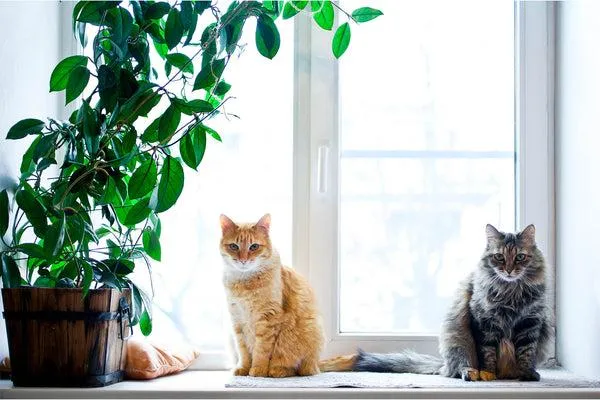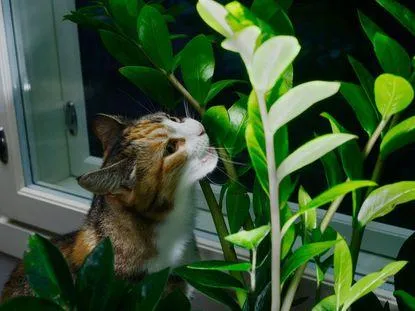The Best Houseplants That Won’t Bother Your Feline Friend
If you share your home with a furry feline companion, finding houseplants that are safe and won’t pose any danger is important. From my experience owning cats over the years, I’ve learned which greenery to avoid and which plants can co-exist peacefully. In this article, I’ll cover over a dozen houseplant varieties that are perfectly acceptable for curious kitties to inspect without risk of toxicity.
Spider Plants
- Spider plants (Chlorophytum comosum) top the list of cat-safe greenery. Their non-toxic leaves are tough enough to withstand an occasional nibble without harm. Spider plants are basically indestructible and thrive with minimal care.
- My tabby, Mittens, loves batting around the spider plant babies that form on sturdy stalks. It’s a great plant to keep kitties entertained without endangering their health. As a bonus, spider plants help clean the indoor air by removing toxins like formaldehyde and benzene.
From my experience, spider plants are truly one of the best options if you share your living space with curious cats. Their low maintenance nature also makes them kind of ideal for forgetful plant parents!
Peace Lilies
Peace lilies (Spathiphyllum) can also withstand an occasional nibble without toxic effect. Their glossy green leaves and fragrant white blooms add elegance to any room. Funny enough, one of my cats seems to have realized peace lilies are safe because I often catch her napping underneath them. Peace lilies thrive in low to medium light and keep pollutants like benzene and trichloroethylene in check. Win-win!
Snake Plants
Snake plants, also called mother-in-law’s tongue (Sansevieria trifasciata), are tough as nails. Their stiff, sword-like leaves are basically indestructible – cats don’t find them very palatable to chew on. Snake plants also boast air-purifying abilities and require only infrequent watering. They basically thrive on neglect, making them an excellent choice if you spend weekends away from home. Snake plants have amazing stabily – one plant can last for decades with proper care.
English Ivy
A trailing variety that’s safe for cats is English ivy (Hedera helix). Its small leaves won’t do any harm if nibbled on accidentally. My sister’s kitten once gobbled down a few ivy leaves in her hyperactive way and was sort of fine. English ivy grows well in low or medium light and brings a bit of cascading foliage to tables and shelves. It creates a stunning illusion and has been used in wedding decor for ages. Just beware ivy can be invasive outdoors – but as a houseplant it makes a lovely eye-catcher.

ZZ Plant
The ZZ plant (Zamioculcas zamiifolia) may not look very exciting with its thick, waxy leaves, but it’s totally cat-proof. ZZ plants tolerate low-light conditions and are super low maintenance – I basically forget to water mine for weeks at a time! According to cat experts, the tough, waxy leaves prevent cats from getting any real “joy” out of chewing. ZZ plants also pump out oxygen and remove toxins like benzene and formaldehyde from indoor air. They’re virtually indestructible and an amazing choice if you frequently forget to water plants.
Peperomia
Peperomias come in a range of varieties with unique foliage shapes and colors like red, pink and yellow-veined leaves. They thrive in medium to low light and prefer moderately moist soil. Cats usually steer clear of peperomias because their leaves contain slight amounts of alkaloids that deter nibbling. My calico kitty was honestly sorta afraid of a funky Peperomia ‘Rosso’ plant I brought home – she’d flee the room every time! While peperomias make interesting conversation pieces, remember that some varieties can be potentially toxic if large quantities are eaten.
Chinese Evergreens
Chinese evergreens or Aglaonema are another sturdy, decorative option suitable for homes with cats. Their beautifully patterned leaves don’t invite chewing and tolerate low light. Chinese evergreens remove indoor toxins like benzene, trichloroethylene and formaldehyde from the air. The plant’s woody stems also deter cats from using it as a scratching post. My Chinese evergreen has been going strong for years with careless affection. It somehow forgives my inconsistent watering schedule and thrives!
Pothos
Golden pothos (Epipremnum aureum) is arguably the best houseplant ever thanks to its incredible durability – it seems to basically survive on air alone! Pothos grows quickly whether hung in a basket or allowed to trail. Their heart shaped leaves are virtually indestructible, making pothos a top choice for plant novices and forgetful waterers alike. Pothos also effectively remove common indoor pollutants like benzene, formaldehyde and xylene from the air. Their trailing vines create a lush look that elevates any space. Best of all, pothos are virtually non-toxic so they pose no threat even if nibbled by curious cats.
So in summary, pothos should easily make the cut as a plant friend for felines as it requires low maintenance with rewarding results. Many cat parents actually grow pothos specifically because it’s so unlikely to face any plant damage from their furry friends. The plant kind of thrives despite anything!

Cast Iron Plant
Funnily enough, the appropriately named cast iron plant (Aspidistra elatior) is yet another bulletproof variety fit for households with cats. Their thick, broad leaves can withstand pretty much anything, including the occasional taste test from a kitty. Cast iron plants prefer low light and thrive on neglect – some homes have passed these indestructible plants down for generations! Cast iron plants are said to date back to Victorian times when their ability to seemingly survive “anything” made them a popular choice. They once again prove themselves as an ideal plant buddy for busy pet parents prone to forgetting watering tasks.
Jade Plant
Jade plants (Crassula ovata) also tolerate pretty much every kind of “abuse” houseplant parents can throw at them – from underwatering to low light conditions. Their thick, hardened leaves don’t hold much appeal for nibbling cats. Perhaps cats sense a jade plant’s toughness makes it an unworthy chew toy. Jade plants remove benzene and formaldehyde from indoor air and live for decades or longer with basic care. Thanks to their impressive resilience, jade plants make a reliable plant pick for homes welcoming cats.
Hoya
Hoyas come in many beautiful forms with waxy, heart-shaped leaves. They thrive in hanging baskets or as a trailing plant. Most hoya varieties boast a non-toxic nature for cats. Their tough, waxy leaves offer little incentive for nibbling. Hoyas also tolerate very low light conditions and dry spells between waterings – though they may take longer to bloom in dimmer spots. Their tough nature makes hoyas a low maintenance choice suitable for cat guardians. And keeping a bloom-producing hoya means a constant supply of tiny wax flowers adding a lovely shine.
So in summary, there are many gorgeous houseplant options that can co-exist peacefully alongside our feline friends. Spider plants, peace lilies, snake plants, English ivy, pothos and more prove themselves as companionable companions. With a little research tailored to your cat’s personality, you can get the houseplant and cat parent combo right. But is it worth removing plants your cat seems to find irresistible? Maybe take it on a case by case basis.
On the other hand, lilies, tulips, datura and certain succulents like jade and aloe should be pet-free zones. Steer clear of toxic varieties no matter how tempting they appear. It’s not worth the risk to your furry friend’s safety. Still, creating a bounty of pet-safe greenery shows your cat they’re cared for. Maintaining a balance between feline and plant interests is possible with delicate compromises on both sides. With some trial and error, humans and cats can share the same living spaces filled with beauty and life!

Houseplants Safe for Cats
| Plant | Toxicity Level | Details |
|---|---|---|
| Spider plant | Non-toxic | Preferred by many cats. Leather-like leaves are difficult to ingest. |
| Peace lily | Mildly toxic | Irritating sap if eaten, but rarely causes problems. Keep out of reach. |
| English ivy | Low toxicity | Attractive but can cause mild digestive upset if eaten. Monitor play closely. |
| Pothos | Non-toxic | Pet-friendly vine spreads along the ground. Avoid if cat chews leaves. |
| Chinese evergreen | Low toxicity | Colorful, hardy foliage plant. May cause mild upset if considerable amount eaten. |
FAQ
-
Are all houseplants safe for cats?
Definitely not. Some common houseplants are poisonous to cats if they eat them. The good news is there are also lots of safe plant options.
-
What are some common poisonous houseplants for cats?
Some plants to avoid having around cats include lilies, tulips, hydrangeas, iris flowers, and poinsettia. At the same time, these plants can sicken cats if they nibble on them. Always keep potentially dangerous plants out of reach.
-
Which houseplants are generally safe for cats?
Plants like peace lilies, english ivy, spider plants, succulents, and bamboo are basically low-risk for cats. As long as your kitty doesn’t absolutely devour a whole pot, they shouldn’t cause an issue. Succulents and bamboo are tough customers even for cats gnawing on them.
-
Should I worry if my cat chews on a safe plant?
For the most part, no. Unless your cat basically eats an entire leaf or stem, occasional nibbling on a non-toxic plant should not get them sick. Still, you don’t want them forming the habit of regularly tasting your greenery. A little spray of bitter apple spray discourages repeat plant munching.
-
What if my cat already ate part of a poisonous plant?
If it just happened, don’t panic. Keep an eye on your furry friend for signs of illness and call your vet for guidance. Remember, some plants are more dangerous than others if eaten. The quicker you get help, the better. Its always smart to have the number for an emergency pet poison control hotline handy, just in case.

-
Can houseplants help with anxiety or stress in cats?
Some people say certain houseplants may assist in reducing stress and anxiety levels for cats, maybe due to the increased sense of greenery indoors. However, the evidence is iffy on how much effect plant life itself has. Having a few safe, cat-friendly houseplants definitely can’t hurt though! Your cat may enjoy simply observing or brushing against them gently.
In summary, many common houseplants pose no risk to kitties if the plants are kept out of paw’s reach. When in doubt, consult online lists or experts to find what’s non-toxic. And remember, poisonous plants should be discarded rather than placed where curious cats can nibble on them. With the right choices, houseplants can add aesthetic appeal and a touch of nature indoors without threatening small creatures.
